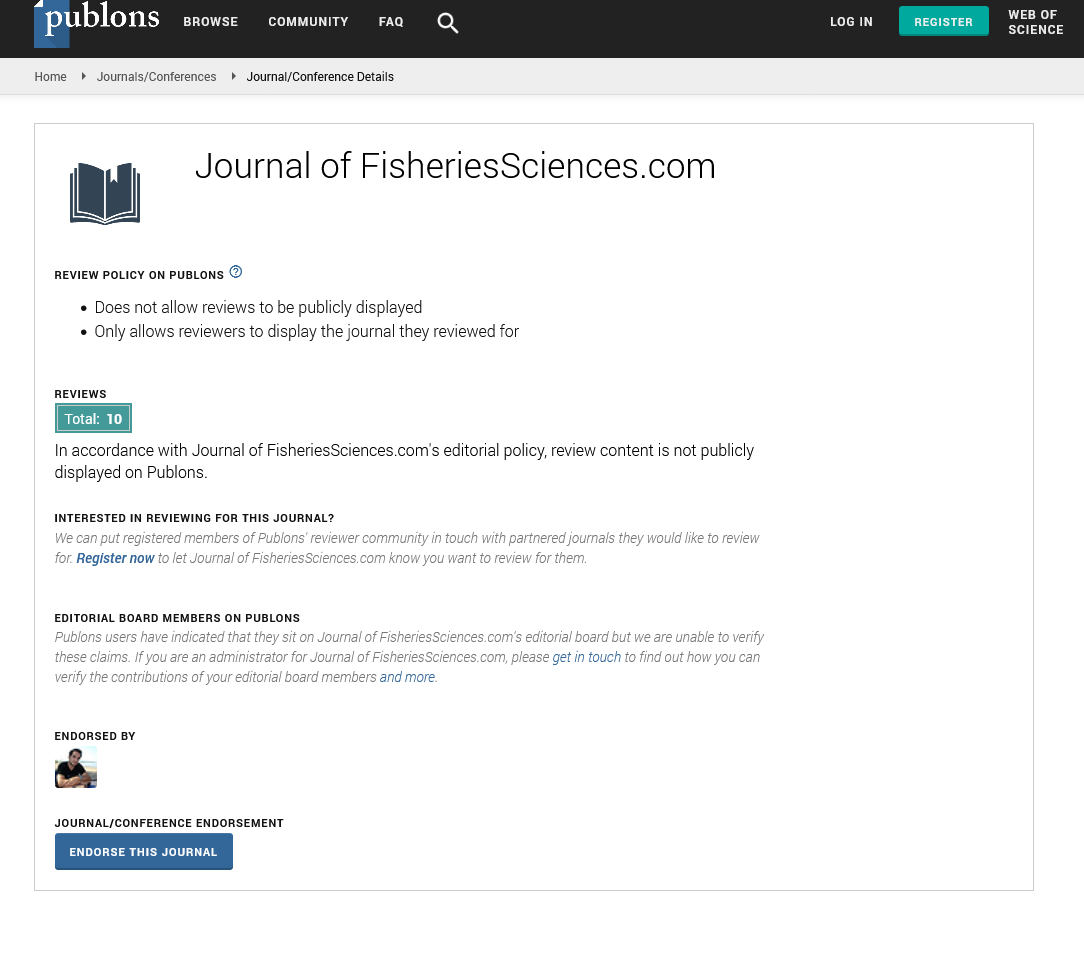Editorial - (2022) Volume 16, Issue 12
Plasic Debris Polluion involved in the Ocean
Molly Alice Williams*
Department of Marine Science, University of Bangor, Egypt
*Correspondence:
Molly Alice Williams, Department of Marine Science, University of Bangor,
Egypt,
Email:
Received: 02-Dec-2022, Manuscript No. IPFS-21-9421;
Editor assigned: 05-Dec-2022, Pre QC No. IPFS-21-9421 (PQ);
Reviewed: 19-Feb-2022, QC No. IPFS-21-9421;
Revised: 24-Dec-2022, Manuscript No. IPFS-21-9421 (R);
Published:
31-Dec-2022, DOI: 10.36648/1307-234X.22.16.117
Abstract
The pollution problem is growing exponentially due to a combination of increasing consumerism and an increase in the use of plastics in manufacturing the products we use on a daily basis. It is common for these items to be single-use items, which are used only once and then thrown away. Marine debris is most commonly generated from two sources: These include litter left on beaches by beach-goers, debris washed into the ocean by storm water runoff, and litter from beach-goers [1] garbage overflowing from ships, boats, and debris discarded at sea. This includes fishing debris such as plastic strapping from bait boxes, discarded fishing line, and derelict fishing gear.
Introduction
The pollution problem is growing exponentially due to a combination of increasing consumerism and an increase in the use of plastics in manufacturing the products we use on a daily basis. It is common for these items to be single-use items, which are used only once and then thrown away. Marine debris is most commonly generated from two sources: These include litter left on beaches by beach-goers, debris washed into the ocean by storm water runoff, and litter from beach-goers [1] garbage overflowing from ships, boats, and debris discarded at sea. This includes fishing debris such as plastic strapping from bait boxes, discarded fishing line, and derelict fishing gear. In the next 50 years, there will be more plastic in the Ocean than fish, according to an estimate of 8 million tonnes of plastic entering the ocean every year. By using plastics excessively and mismanaging waste, we are killing countless marine animals by entanglement and poisoning. Even the seafood we eat is contaminated with chemicals due to our waste addiction and waste management mismanagement. Plastic trash mainly gets to the oceans from land [2]. It is also carried to the sea by major rivers that act as conveyor belts, gathering trash as they move downstream. Once at sea, the plastic trash mostly stays in coastal waters. Nevertheless, once it is transported by ocean currents, plastic waste can end up in all parts of the world. It is gradually broken down into small particles of plastic waste, often roughly the size of a fifth of an inch, by light, wind, and wave action. There are hundreds of microplastics floating through the water column today, and they are found in every corner of the planet from Mount Everest, the tallest peak, to the Mariana Trench, the deepest trough. It is becoming increasingly difficult to distinguish between pieces of micro plastic [3]. There have also been reports of plastic microfibers floating through the air and in the drinking water system. It is possible for plastic to be dangerous for humans in different ways. Chemicals like lead, cadmium, and mercury pose a direct threat to human health through plastics. The same toxins have also been found in many fish in the ocean, which can be very harmful to humans. Among some plastics there is the substance diethylhexyl phthalate (DEHP), which makes them toxic. In addition, plastics contain other toxins that can cause cancers, birth defects, immune system issues, and developmental problems in children. Other plastics that are toxic include BPA, or bisphenol-A, and phthalates (both of which have been mentioned above). These two issues are of great concern to human health [4]. BPA can be found in many things such as plastic bottles and food packaging materials. Polymer chains of BPA break down over time, and can enter the human body in many ways, including drinking contaminated water and eating fish that is exposed to the broken down toxins[5]. In particular, toxic chemicals such as BPA interfere with human hormones.
Conclusion
In order to protect yourself from contamination, you should probably avoid having a diet that is mainly composed of fish, since most is probably contaminated. As members of this fragile ecosystem, one of the most effective things we can do is to be responsible for our garbage. Our goal should be to avoid purchasing plastic-wrapped products whenever possible. Recycling plastic when we do use it is always a good idea. Consider using paper bags instead of plastic or bringing your own Make.
REFERENCES
Google Scholar, Crossref, Indexed at
Google Scholar, Crossref, Indexed at
Google Scholar, Crossref, Indexed at
Google Scholar, Crossref, Indexed at
Google Scholar, Crossref, Indexed at
- Hammer J, Kraak MH, Parsons JR (2012) Plastics in the marine environment: the dark side of a modern gift. Rev Environ Contam Toxicol Rev Environ Contam T 220: 1-44.
- Jambeck Jenna R, Geyer Roland, Wilcox Chris, Siegler Theodore R, Perryman Miriam, et al. (2015) Andrady Anthony, Narayan Ramani, Law Kara Lavender, Plastic waste inputs from land into the ocean. Science 347: 768-771.
- Jin Yuanxiang, Xia Jizhou, Pan Zihong ,Yang Jiajing, Wang Wenchao, et al. (2018) Polystyrene microplastics induce microbiota dysbiosis and inflammation in the gut of adult zebrafish. Environmental Pollution 235: 322-329.
- Rastelli Marialetizia, Cani Patrice D, Knauf Claude (2019) the Gut Microbiome Influences Host Endocrine Functions. Endocrine Reviews 40: 1271-1284.
- Kannan Kurunthachalam, Vimalkumar Krishnamoorthi (2021) A Review of Human Exposure to Microplastics and Insights into Microplastics as Obesogens. Frontiers in Endocrinology 12: 724989.
Citation: Williams MA (2021) Plastic Debris Pollution in the Ocean. J Fish Sci, Vol.16 No. 12: 93.






